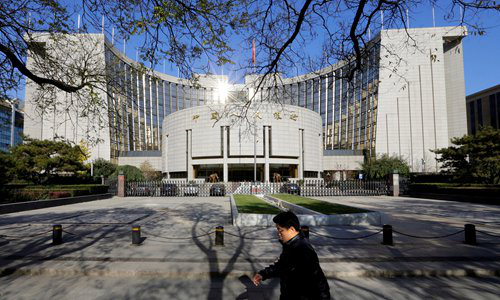
发布时间:2020-05-14

A man walks past the headquarters of the People's Bank of China, the central bank, in Beijing. File photo: VCG
China's macro leverage ratio saw a notable rise in the first quarter due to the impact of COVID-19, the country's central bank said on Tuesday, noting however, it's merely a phased uptick as part of efforts to ramp up credit support for the real economy.
The uptick was indicative of countercyclical policy support for the real economy to resume operations, the People's Bank of China (PBC) said in a statement posted on its website, citing an unidentified official with its statistics and analysis department.
The nation's macro leverage ratio has stayed steady since 2017. The reading posted a net fall in 2018 before recording a rise of 5.7 percentage points in 2019, well below an average annual growth of 10 percentage points in 2008-16, per the central bank. The reading for the first quarter was not disclosed.
Provided that epidemic containment and prevention becomes normalized, countercyclical policymaking ought to take into consideration both efforts to fight the disease and economic and social development, prioritizing the support for recommencing the real economy while preventing financial risks, read the PBC statement.
A phased-up spiral in the macro leverage ratio should be allowed in due course in a bid to ramp up credit support for the real economy, the central bank stressed. "This actually creates conditions for [the nation] to better maintain reasonable macro leverage levels in the future."
In a note sent to the Global Times on Tuesday, UBS chief China economist Wang Tao expected policy easing to continue, with additional 50 basis point reserve requirement cuts plus policy rate cuts of 10-20 basis points.
"The year-to-date strong momentum of credit growth acceleration may not last late into the third quarter and fourth quarter, as the government may reassess the strength of policy stimulus when the economy fully comes back to normal and global demand recovers," she said.
In a sign of more effective policy transmission, results of a PBC survey of 10,000 firms engaging in the real economy showed that by the end of April, industrial production had largely been restored to pre-virus levels while the services sector posted a continued increase in reopening rates, the central bank revealed Tuesday.
According to the findings, 97.5 percent of the surveyed firms had resumed production, and more than half of industrial firms registered an equipment utilization rate equaling or topping the average levels seen in the second quarter of last year.
The reassuring words for financial support came after the announcement of a slew of financial data on Monday.
New yuan lending hit 1.7 trillion yuan ($240.28 billion) in April, beating previous market estimates. Total social financing also came in stronger than expected to total 2.98 trillion yuan in April.
More noteworthily, broad M2 money supply growth edged up to 11.1 percent year-on-year in April from 10.1 percent in March, while M1 narrow money supply climbed to 5.5 percent from 5 percent in the previous month.
Outstanding yuan-denominated loans stood at 161.91 trillion yuan at the end of April, an increase of 13.1 percent year-on-year. The growth rate was the highest since June 2019.
The central bank said Tuesday that anti-virus sectors and virus-ravaged industries were getting big financial support while much of the medium- to long-term loans have gone to key areas including manufacturing, infrastructure and services. Lending tailored for small and micro-sized businesses also grew at an accelerated pace.
Source:Globaltimes.cn